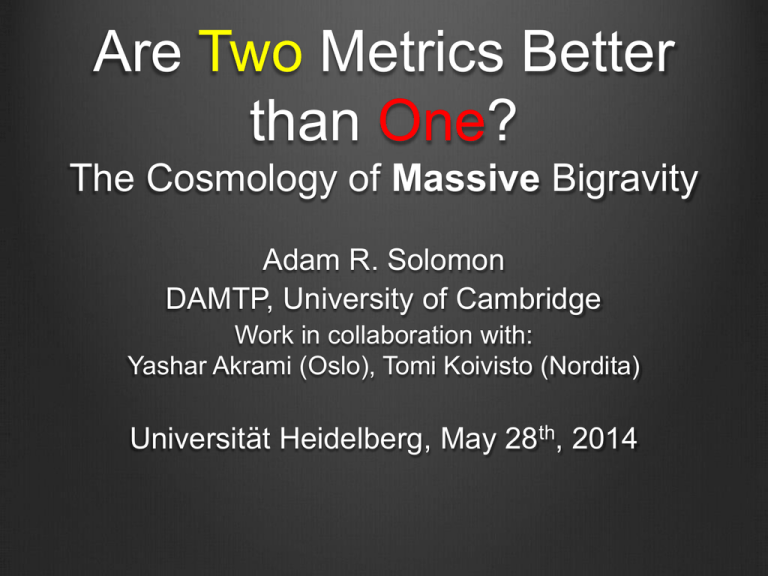massive bigravity - damtp
advertisement

Are Two Metrics Better
than One?
The Cosmology of Massive Bigravity
Adam R. Solomon
DAMTP, University of Cambridge
Work in collaboration with:
Yashar Akrami (Oslo), Tomi Koivisto (Nordita)
Universität Heidelberg, May 28th, 2014
Why consider two metrics in
the first place?
(Death to Occam’s razor?)
Adam Solomon
Why consider two metrics?
Field theoretic interest: how do we construct
consistent interactions of multiple spin-2 fields?
NB “Consistent” crucially includes ghost-free
My motivation: modified gravity massive graviton
1) The next decade will see multiple precision tests of
GR – we need to understand the alternatives
2) The accelerating universe
Adam Solomon
Dark energy or modified gravity?
Einstein’s equation + the Standard Model predict a decelerating
universe, but this contradicts observations. The expansion of
the Universe is accelerating!
What went wrong?? Two possibilities:
Dark energy: Do we need to include new “stuff” on the RHS?
Modified gravity: Are we using the wrong equation to describe
gravity at cosmological distances?
Adam Solomon
Cosmic acceleration has theoretical problems
which modified gravity might solve
Technically natural self-acceleration: Certain
theories of gravity may have late-time acceleration
which does not get destabilized by quantum
corrections.
This is THE major problem with a simple cosmological
constant
Degravitation: Why do we not see a large CC from
matter loops? Perhaps an IR modification of gravity
makes a CC invisible to gravity
This is natural with a massive graviton due to short
range
Adam Solomon
Why consider two metrics?
Take-home message: Massive bigravity is a natural,
exciting, and still largely unexplored new direction in
modifying GR.
Adam Solomon
How can we do gravity beyond GR?
Some famous examples
Brans-Dicke (1961): make Newton’s constant dynamical:
GN = 1/ϕ, gravity couples non-minimally to ϕ
f(R) (2000s): replace Einstein-Hilbert term with a general
function f(R) of the Ricci scalar
Adam Solomon
How can we do gravity beyond GR?
These theories are generally not simple
Even f(R) looks elegant in the action, but from a
degrees of freedom standpoint it is a theory of a scalar
field non-minimally coupled to the metric, just like
Brans-Dicke, Galileons, Horndeski, etc.
Adam Solomon
How can we do gravity beyond GR?
Most attempts at modifying GR are guided by Lovelock’s
theorem (Lovelock, 1971):
GR is the unique theory of gravity which
Only involves a rank-2 tensor
Has second-order equations of motion
Is in 4D
Is local and Lorentz invariant
The game of modifying gravity is played by breaking one
or more of these assumptions
Adam Solomon
Einstein-DilatonGauss-Bonnet
Tessa Baker
Cascading gravity
✓
Strings & Branes
f
DGP
Randall-Sundrum Ⅰ& Ⅱ
R
⇤
2T gravity
Higher dimensions
Lorentz violation
Hoř ava-Lifschitz
◆
Conformal gravity
f (G)
Some degravitation
scenarios
Non-local
Higher-order
f (R)
General Rμν Rμν ,
☐R,etc.
Kaluza-Klein
Generalisations
of SEH
Modified Gravity
New degrees of freedom
Gauss-Bonnet
arXiv:
1310.1086
1209.2117
1107.0491
1110.3830
Einstein-Aether
Lorentz violation
TeVeS
Lovelock gravity
Vector
Scalar-tensor & Brans-Dicke
Ghost condensates
Galileons
the Fab Four
Scalar
Massive gravity
Bigravity
Chern-Simons
Cuscuton
Tensor
EBI
Chaplygin gases
Bimetric MOND
KGB
Coupled Quintessence
f(T)
Einstein-Cartan-Sciama-Kibble
Horndeski theories
Torsion theories
Another path: degrees of freedom
(or, Lovelock or Weinberg?)
GR is unique.
But instead of thinking about that uniqueness
through Lovelock’s theorem, we can also
remember that (Weinberg, others, 1960s)…
GR = massless spin-2
A natural way to modify GR: give the graviton
mass!
Adam Solomon
Non-linear massive gravity is a
very recent development
At the linear level, the correct theory of a massive
graviton has been known since 1939 (Fierz, Pauli)
But in the 1970s, several issues – most notably a
dangerous ghost instability (mode with wrong-sign
kinetic term) – were discovered
Adam Solomon
Non-linear massive gravity is a
very recent development
Only in 2010 were these issues overcome when de
Rham, Gabadadze, and Tolley (dRGT) wrote down
the ghost-free, non-linear theory of massive gravity
See the reviews by
de Rham arXiv:1401.4173, and
Hinterbichler arXiv:1105.3735
Adam Solomon
dRGT Massive Gravity in a Nutshell
The unique non-linear action for a single massive spin-2
graviton is
where fμν is an arbitrary reference metric which must be
chosen at the start
βn are the free parameters; the graviton mass is ~m2βn
The en are elementary symmetric polynomials given by…
Adam Solomon
For a matrix X, the elementary symmetric
polynomials are ([] = trace)
Adam Solomon
Much ado about a reference
metric?
There is a simple (heuristic) reason that massive
gravity needs a second metric: you can’t construct a
non-trivial interaction term from one metric alone:
We need to introduce a second metric to construct
interaction terms.
There are many dRGT massive gravity theories
What should this metric be?
Adam Solomon
From massive gravity to
massive bigravity
Simple idea (Hassan and Rosen, 2011): make the
reference metric dynamical
Resulting theory: one massless graviton and one
massive – massive bigravity
Adam Solomon
From massive gravity to
massive bigravity
By moving from dRGT to bimetric massive gravity, we
avoid the issue of choosing a reference metric
(Minkowski? (A)dS? Other?)
Trading a constant matrix (fμν) for a constant scalar (Mf) –
simplification!
Allows for stable, flat FRW cosmological solutions (do
not exist in dRGT)
Bigravity is a very sensible theory to consider
Adam Solomon
Massive bigravity has selfaccelerating cosmologies
Homogeneous and isotropic solution:
the background dynamics are determined by
As ρ -> 0, y -> constant, so the mass term approaches a (positive)
constant late-time acceleration
NB: We are choosing (for now) to only couple matter to one metric,
gμν
Adam Solomon
Massive bigravity effectively
competes with ΛCDM
A comprehensive comparison to background data
was undertaken by Akrami, Koivisto, & Sandstad
[arXiv:1209.0457]
Data sets:
Luminosity distances from Type Ia supernovae (Union
2.1)
Position of the first CMB peak – angular scale of sound
horizon at recombination (WMAP7)
Baryon-acoustic oscillations (2dFGRS, 6dFGS, SDSS
and WiggleZ)
Adam Solomon
Massive bigravity effectively
competes with ΛCDM
A comprehensive comparison to background data
was undertaken by Akrami, Koivisto, & Sandstad
(2012), arXiv:1209.0457
Take-home points:
No exact ΛCDM without explicit cosmological constant
(vacuum energy)
Dynamical dark energy
Phantom behavior (w < -1) is common
The “minimal” model with only β1 nonzero is a viable
alternative to ΛCDM
Adam Solomon
Massive bigravity effectively
competes with ΛCDM
Y. Akrami, T. Koivisto, and M. Sandstad [arXiv:1209.0457]
See also F. Könnig, A. Patil, and L. Amendola [arXiv:1312.3208];
ARS, Y. Akrami, and T. Koivisto [arXiv:1404.4061]
On to the perturbations…
These models provide a good fit to the background data, but
look similar to ΛCDM and can be degenerate with each
other.
Can we tease these models apart by looking beyond the
background to structure formation?
(Spoiler alert: yes.)
Adam Solomon
Scalar perturbations in
massive bigravity
Extensive analysis of perturbations undertaken by
ARS, Y. Akrami, and T. Koivisto, arXiv:1404.4061
See also Könnig and Amendola, arXiv:1402.1988
Linearize metrics around FRW backgrounds, restrict
to scalar perturbations {Eg,f, Ag,f, Fg,f, and Bg,f}:
Full linearized Einstein equations (in cosmic or
conformal time) can be found in ARS, Akrami, and
Koivisto, arXiv:1404.4061
Adam Solomon
Scalar perturbations in
massive bigravity
ARS, Y. Akrami, and T. Koivisto, arXiv:1404.4061 (gory details)
Most observations of cosmic structure are taken in
the subhorizon limit:
Specializing to this limit, and assuming only matter is
dust (P=0)…
Five perturbations (Eg,f, Ag,f, and Bf - Bg) are
determined algebraically in terms of the density
perturbation δ
Meanwhile, δ is determined by the same evolution
equation as in GR:
Adam Solomon
(GR and massive bigravity)
In GR, there is no anisotropic stress so Eg
(time-time perturbation) is related to δ
through Poisson’s equation,
In bigravity, the relation beteen Eg and δ is
significantly more complicated
modified structure growth
Adam Solomon
The “observables”:
Modified gravity parameters
We calculate three parameters which are commonly
used to distinguish modified gravity from GR:
Growth rate/index (f/γ): measures growth of
structures
Modification of Newton’s constant in Poisson eq.
(Q):
GR:
Anisotropic stress (η):
Adam Solomon
The “observables”:
Modified gravity parameters
We have analytic solutions (messy) for Ag and
Eg as (stuff) x δ, so
Can immediately read off analytic expressions for
Q and η:
(hi are non-trivial functions of time; see ARS,
Akrami, and Koivisto arXiv:1404.4061, App. B)
Can solve numerically for δ using Q and η:
Adam Solomon
The minimal model (B1 only)
SNe only:
B1 = 1.3527 ± 0.0497
SNe + CMB + BAO:
B1 = 1.448 ± 0.0168
1.2
Growth of Structures
SNe Ia
CMB/BAO
Combined
ARS, Y. Akrami, & T. Koivisto
arXiv:1404.4061
1
Likelihood
0.8
0.6
0.4
0.2
0
1.1
Adam Solomon
1.2
1.3
1.4
B1
1.5
1.6
1.7
The minimal model (B1 only)
k = 0.1 h/Mpc
1.05
1
0.95
0.9
0.85
0.8
0.75
0.7
0.65
0.6
f(z): B1 = 1.35
f(z): B1 = 1.45
Best-fit Wg: B1 = 1.35
g
Best-fit W : B1 = 1.45
0.55
0.5
0
1
2
3
4
5
z
k = 0.1 h/Mpc:
γ = 0.46 for B1 = 1.35
γ = 0.48 for B1 = 1.45
The minimal model (B1 only)
k = 0.1 h/Mpc
1
Q: B1 = 1.35
Q: B1 = 1.45
h: B1 = 1.35
h: B1 = 1.45
Euclid:
0.98
will measure
η within 10%
0.96
0.94
0.92
0.9
0.88
0.86
0
1
2
3
4
5
z
k = 0.1 h/Mpc:
γ = 0.46 for B1 = 1.35
γ = 0.48 for B1 = 1.45
21 cm HI forecasts
arXiv:1405.1452
Adam Solomon
Euclid and SKA forecasts
for bigravity in prep.
[work with Yashar Akrami (Oslo),
Tomi Koivisto (Nordita), and
Domenico Sapone (Madrid)]
Adam Solomon
Two-parameter models
Bi parameters are degenerate at background level when
more than one are nonzero
Simple analytic argument: see arXiv:1404.4061
Can structure formation break this degeneracy?
Yes!
Adam Solomon
Two-parameter models
B1, B3 ≠ 0; ΩΛeff ~ 0.7
k = 0.1 h/Mpc
1.1
1
0.9
0.8
0.7
f(z): B 1 = 1.1
f(z): B1 = 1.45
f(z): B 1 = 2.5
f(z): B 1 = 5
g
Best-fit W
: B1 = 1.1
g
Best-fit W : B1 = 1.45
Best-fit Wg: B1 = 2.5
g
Best-fit W : B1 = 5
0.6
0.5
Adam Solomon
0
1
2
3
z
4
5
Two-parameter models
B1, B3 ≠ 0; ΩΛeff ~ 0.7
k = 0.1 h/Mpc
0.65
0.6
GR
Best-fit g
0.55
0.5
B1 = 1.45
0.45
0.4
Adam Solomon
0
2
4
6
B1
8
10
Two-parameter models
B1, B3 ≠ 0; ΩΛeff ~ 0.7
k = 0.1h/Mpc
1
0.98
0.96
0.94
0.92
0.9
0.88
0.86
Q: z = 0.5
Q: z = 1.5
h: z = 0.5
h: z = 1.5
B1 = 1.45
0.84
0.82
Adam Solomon
0
2
4
6
B1
8
10
Two-parameter models
Recall: Bi parameters are degenerate at background level
when more than one are nonzero
Simple analytic argument: see arXiv:1404.4061
Can structure formation break this degeneracy?
Yes!
See arXiv:1404.4061 for extensive analysis
We repeated the previous analysis for all cosmologically
viable two-parameter models
Note: we found an instability in the B1-B2 model –
dangerous?
Adam Solomon
Bimetric Cosmology: Summary
The β1-only model is a strong competitor to ΛCDM and is
gaining increasing attention
Same number of free parameters
Technically natural?
This model – as well as extensions to other interaction
terms – deviate from ΛCDM at background level and in
structure formation. Euclid (2020s) should settle the issue.
Extensive analysis of perturbations undertaken by ARS,
Akrami, & Koivisto in arXiv:1404.4061
See also Könnig and Amendola, arXiv:1402.1988
Adam Solomon
Generalization:
Doubly-coupled bigravity
Question: Does the dRGT/Hassan-Rosen bigravity action
privilege either metric?
No: The vacuum action (kinetic and potential terms) is
symmetric under exchange of the two metrics:
Symmetry:
Adam Solomon
Generalization:
Doubly-coupled bigravity
The matter coupling breaks this symmetry. We can restore it
(i.e., promote it from the vacuum theory to the full theory) by
double coupling the matter:
New symmetry for full action:
See Y. Akrami, T. Koivisto, D. Mota, and M. Sandstad
[arXiv:1306.0004] for introduction and background cosmology
Adam Solomon
Doubly-coupled cosmology
Y. Akrami, T. Koivisto, D. Mota, and M. Sandstad [arXiv:1306.0004]
Novel features (compared to singly-coupled):
Can have conformally-related solutions,
These solutions can mimic exact ΛCDM (no dynamical DE)
Only for special parameter choices
Models with only β2 ≠ 0 or β3 ≠ 0 are now viable
Adam Solomon
Doubly-coupled cosmology
Y. Akrami, T. Koivisto, D. Mota, and M. Sandstad [arXiv:1306.0004]
Candidate partially massless theory has non-trivial dynamics
β0 = β4 = 3β2, β1 = β3 = 0: has partially-massless symmetry
around maximally symmetric (dS) solutions (arXiv:1208.1797)
This is a new gauge symmetry which eliminates the helicity-0
mode (no fifth force, no vDVZ discontinuity) and fixes and
protects the value of the CC/vacuum energy
Attractive solution to the CC problems!
However the singly-coupled version does not have non-trivial
cosmologies
Our doubly-coupled bimetric theory results in a natural
candidate PM gravity with viable cosmology
Remains to be seen: is this really partially massless?
All backgrounds? Fully non-linear symmetry?
Adam Solomon
Problem: how do we relate
theory to observation?
There is no single “physical” metric
See Akrami, Koivisto, and ARS [arXiv:1404.0006]
So how do we connect observables (e.g., luminosity
distance, redshift) to theory parameters?
GR: derivations of these observables rely heavily on
knowing what the metric of spacetime is
Doubly-coupled theory possess mathematically two
metrics, but physically none
Need to step beyond the confines of metric geometry
Adam Solomon
Two metrics or none?
Y. Akrami, T. Koivisto, and ARS [arXiv:1404.0004]
Consider a Maxwell field
After all, we make observations by tracking photons!
Imagine it is minimally coupled to an effective metric, hμν:
This implies
But the 00-00, 00-ii, and ii-ii components of this cannot be
satisfied simultaneously!
No effective metric for photons
Adam Solomon
Two metrics or none?
Y. Akrami, T. Koivisto, and ARS [arXiv:1404.0004]
The point particle of mass m:
has the “geodesic” equation:
Is this the geodesic equation for any metric?
NO.
Adam Solomon
Two metrics or none?
Y. Akrami, T. Koivisto, and ARS [arXiv:1404.0004]
Rewrite the action
as
where
Adam Solomon
Two metrics or none?
Y. Akrami, T. Koivisto, and ARS [arXiv:1404.0004]
Rewrite the action
as
where
It is easy to see that the point particle action can be written
Adam Solomon
Two metrics or none?
Y. Akrami, T. Koivisto, and ARS [arXiv:1404.0004]
Point particles move in an effective geometry defined by
This is not a metric spacetime. Rather, it is the line element
of a Finsler geometry.
Adam Solomon
Two metrics or none?
Y. Akrami, T. Koivisto, and ARS [arXiv:1404.0004]
Finsler geometry: the most general line element that is
homogeneous of degree 2 in the coordinate intervals dxμ
Related to disformal couplings (cf. Bekenstein, gr-qc/9211017)
We can define a quasimetric:
Adam Solomon
Two metrics or none?
Y. Akrami, T. Koivisto, and ARS [arXiv:1404.0004]
We can define proper time the usual way (dτ = -ds):
Massive point particles move on timelike geodesics of unit norm
Can now extend to massless particles as in GR (einbein)
Crucial question: Does this describe photons??
Can be straightforwardly extended to multimetric theories
Adam Solomon
Two metrics or none?
Y. Akrami, T. Koivisto, and ARS [arXiv:1404.0004]
“The geometry that emerges for an observer in a bimetric
spacetime depends quite nontrivially upon, in addition to the
two metric structures, the observer's four-velocity. This means
she is disformally coupled to her own four-velocity, and thus
effectively lives in a Finslerian spacetime.”
Adam Solomon
Summary
1. Massive gravitons can exist
2. Interacting spin-2 fields can exist
3. Late-time acceleration can be addressed (self-acceleration)
4. Dynamical dark energy – serious competitor to ΛCDM!
5. Clear non-GR signatures in large-scale structure: Euclid
6. Can couple both metrics to matter: truly bimetric gravity
7. Exciting cosmological implications: exact ΛCDM, PM, etc.
8. Conceptual challenges: mathematically two metrics, physically none.
Finsler geometry?
“Paradoxically, once we have doubled the geometry, we lose the ability
to use its familiar methods. This is a call to go back to the basics, and
rediscover the justifications for results which we have taken for granted
for the better part of the last century.”
Adam Solomon
What’s next?
Singly-coupled bigravity:
Forecasts for Euclid
Superhorizon scales: CMB (Boltzmann + ISW), inflation, tensor
modes
Nonlinear regime (N-body simulations)
Inflation from bigravity
Instabilities? Do they exist, are they dangerous?
Doubly-coupled bigravity:
Light propagation (connection to observables)
Cosmological constraints (subhorizon, superhorizon, nonlinear)
Inflationary constraints
Local constraints
Dark matter
Adam Solomon
Massive bigravity has selfaccelerating cosmologies
arXiv:1209.0457
Plot: ratio of the two scale factors as a function of
redshift (in a particular model)
Adam Solomon
Bi parameters can be degenerate
in FRW background
The mass term in the Friedmann equation acts as an
effective CC density today:
while y0 obeys a quartic equation (with Ωm + ΩΛeff= 1):
So if multiple Bi parameters are nonzero, then fixing ΩΛeff
only restricts to a parameter subspace. E.g., if B1, B2 ≠ 0:
Adam Solomon
Bi parameters can be degenerate
in FRW background
Adam Solomon
Subhorizon evolution equations
g metric
Energy constraint (0-0 Einstein equation):
Trace i-j Einstein equation:
Off-diagonal (traceless) i-j Einstein equation:
Adam Solomon
Subhorizon evolution equations
f metric
Energy constraint (0-0 Einstein equation):
Trace i-j Einstein equation:
Off-diagonal (traceless) i-j Einstein equation:
Adam Solomon
The minimal model (B1 only)
k = 0.1 h/Mpc
0.56
GR
0.54
0.52
Best-fit g
0.5
B1 = 1.35
0.48
0.46
B1 = 1.45
0.44
0.42
0.4
1.1
Solomon
k Adam
= 0.1
h/Mpc:
1.2
1.3
1.4
B1
γ = 0.46 for B1 = 1.35
1.5
1.6
1.7
γ = 0.48 for B1 = 1.45
The minimal model (B1 only)
k = 0.1h/Mpc
1
Q: z = 0.5
Q: z = 1.5
h: z = 0.5
h: z = 1.5
Euclid:
0.98
will measure
η within 10%
B1 = 1.45
0.96
0.94
0.92
0.9
0.88
B1 = 1.35
0.86
1.1
Solomon
k Adam
= 0.1
h/Mpc:
1.2
1.3
1.4
B1
γ = 0.46 for B1 = 1.35
1.5
1.6
1.7
γ = 0.48 for B1 = 1.45
Two metrics or none?
Y. Akrami, T. Koivisto, and ARS [arXiv:1404.0004]
We can play the same game for other fields, e.g., a
canonical scalar.
This generally leads to a spacetime-varying mass for the
scalar
However, a massless scalar does have an effective metric,
Adam Solomon









